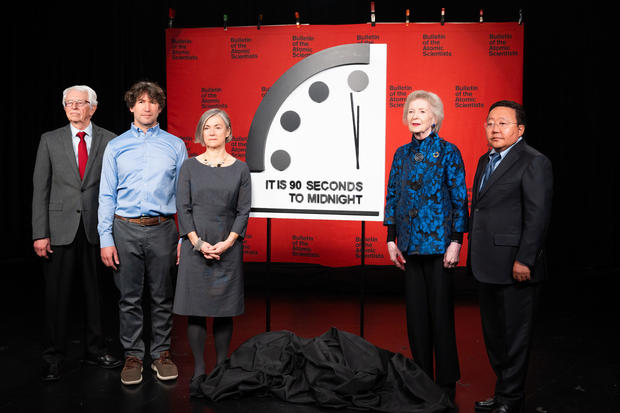For three years, the hands of the world’s Doomsday clock were set at 100 seconds to midnight. But now, as Ukraine approaches a year of war, the climate crisis continues and other actions threaten humanity, the world has officially crept even closer to what the Bulletin of the Atomic Scientists calls “global catastrophe.”
On Tuesday, the hands of the Doomsday clock reached their closest position to midnight yet. The clock is not a forecasting tool, but rather a symbol created by the Bulletin of the Atomic Scientists in 1947 to shed light on how humanity’s actions are causing problems that could have mass consequences.
“We are living in a time of unprecedented danger, and the Doomsday Clock time reflects that reality,” Bulletin president and CEO Rachel Bronson said. “Ninety seconds to midnight is the closest the clock has ever been set to midnight, and it’s a decision our experts do not take lightly.”
The reason for the 10-second move toward metaphorical Doomsday is largely because of the war in Ukraine, which is quickly approaching its one-year anniversary. In a statement, the Bulletin explained that the war has “raised profound questions” on how nations interact, as well as an apparent downfall in international conduct. The war has had far-reaching implications, impacting global crops, gas supply and rampant risk to nuclear reactor sites.
“And worst of all, Russia’s thinly veiled threats to use nuclear weapons remind the world that escalation of the conflict—by accident, intention, or miscalculation—is a terrible risk,” the announcement says. “The possibility that the conflict could spin out of anyone’s control remains high.”
The threat of nuclear war is also a factor in the world’s inching toward midnight, as is the climate crisis, which the need to address has only increased in urgency. Recent months have revealed record-high carbon dioxide emissions, worsening weather extremes and “cascading effects” of crop failures, diseases and weakening infrastructure, the Bulletin says.
Biological threats such as COVID-19 and disinformation were also listed as factors for Doomsday clock change.
For Mary Robinson, a former United Nations High Commissioner for Human Rights, said that the latest move on the clock is “sounding an alarm for the whole of humanity.”
“We are on the brink of a precipice,” Robinson, who is also a member of global independent leaders group The Elders, said. “But our leaders are not acting at sufficient speed or scale to secure a peaceful and liveable planet. … The science is clear, but the political will is lacking. This must change in 2023 if we are to avert catastrophe. We are facing multiple, existential crises. Leaders need a crisis mindset.”
While the Bulletin uses the clock to warn the world of dangers, the group says concretely that they are “not predicting the future.” Rather, the clock is a sort-of analysis of international events, trends and public and official efforts to mitigate harm to humanity.
“The Bulletin is a bit like a doctor making a diagnosis,” the group says. “We look at data, as physicians look at lab tests and X-rays, and also take harder-to-quantify factors into account, as physicians do when talking with patients and family members.”

